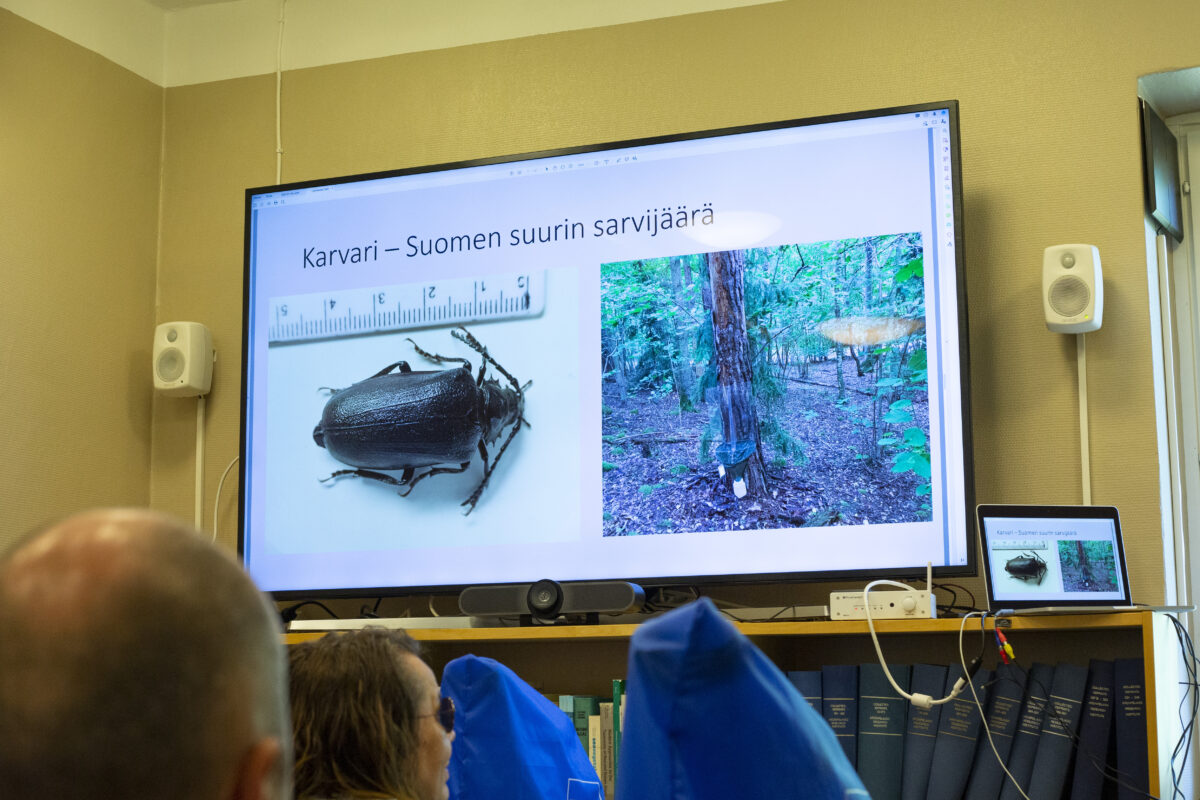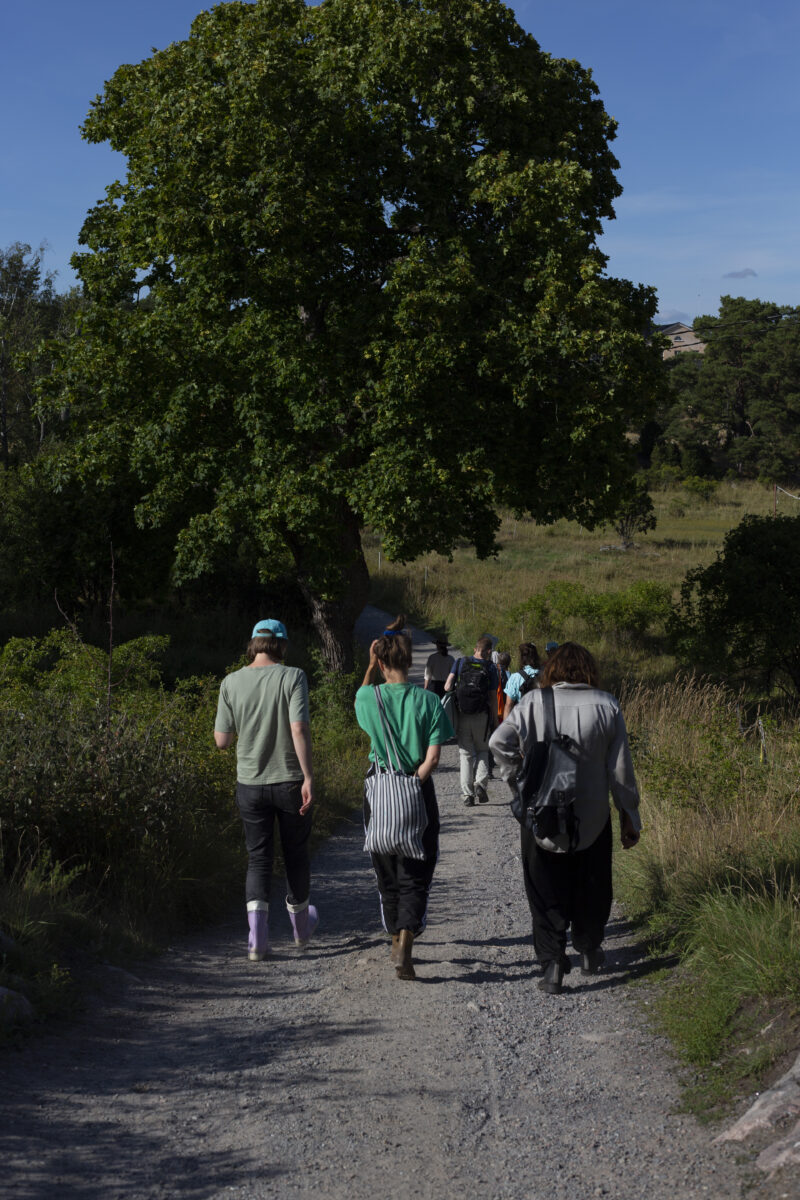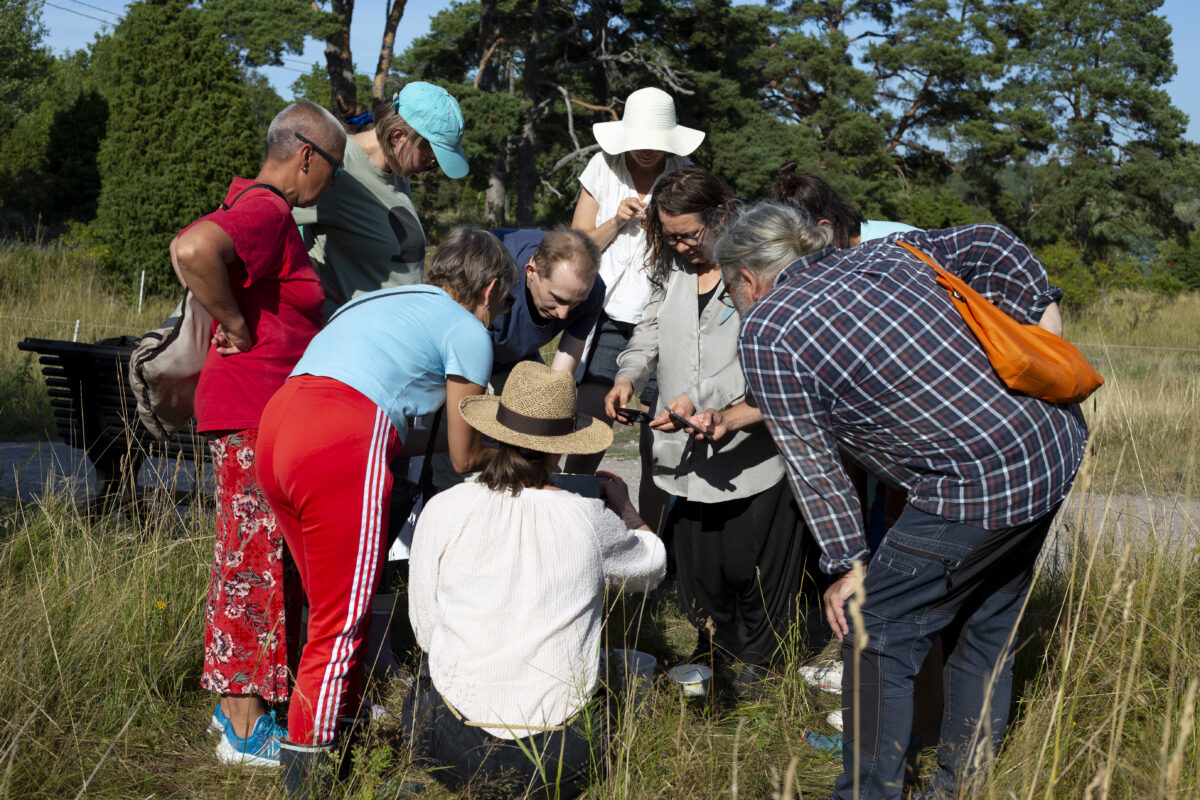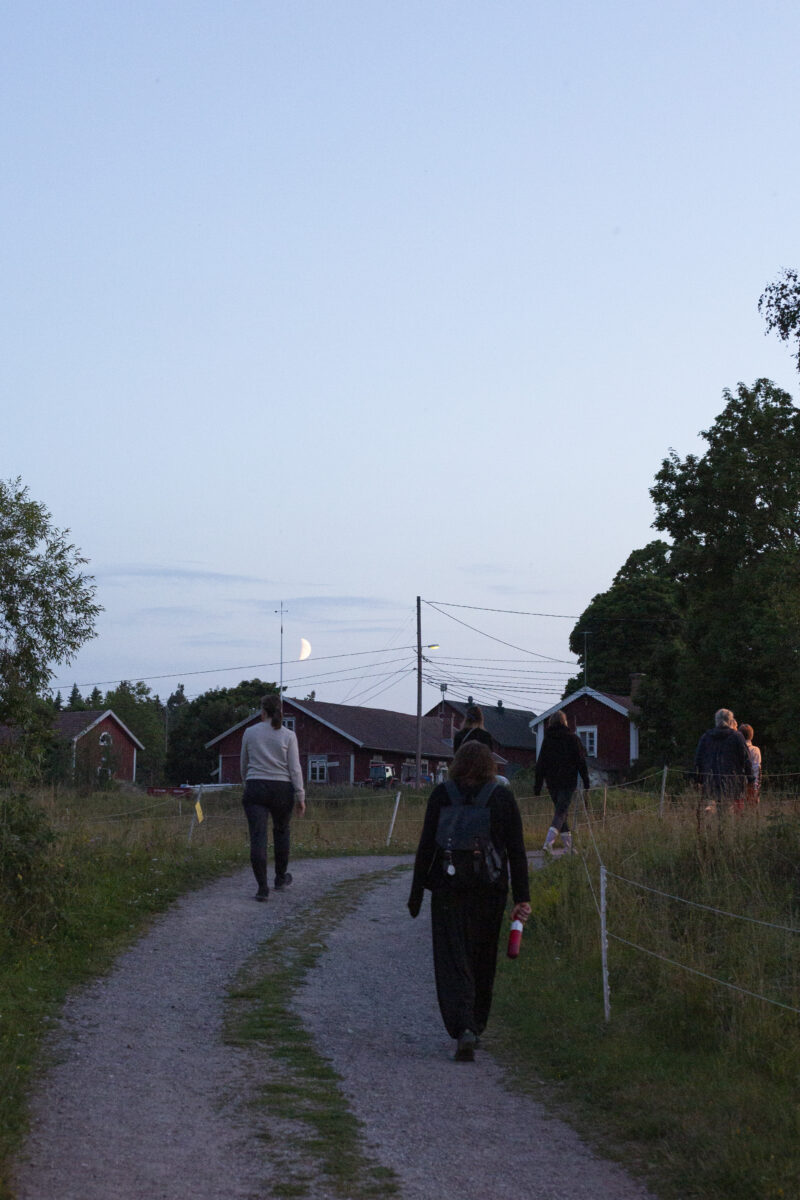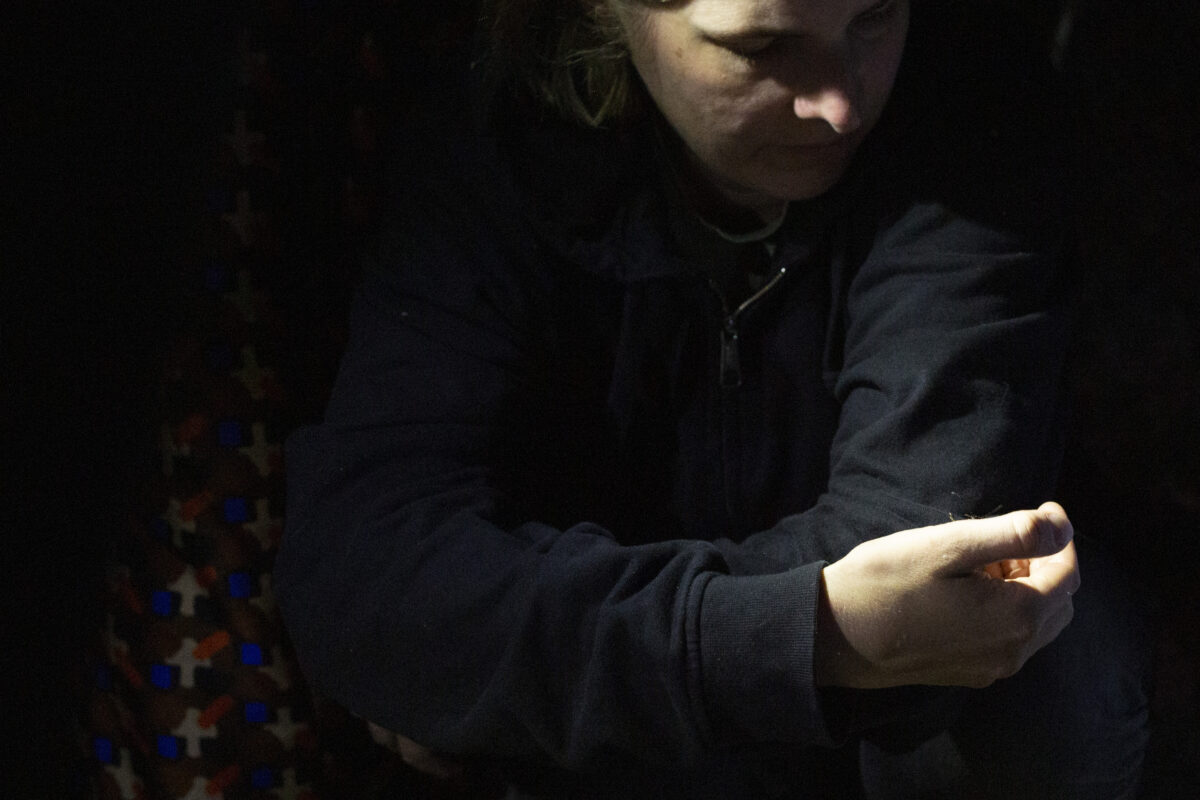Field notes: Walk like a Beetle
Beetle Workshop with Arja Renell and Sampsa Malmberg
Archipelago Research Institute, Seili
Thursday 4.8.2022, 13.00–00.00
The karvari (Prionus coriarius), a variety of long-horn beetle, is nocturnal. Its brown, shiny body scuttles amongst the decomposing pines during twilight hours: here, it nestles its eggs deep in the soil contouring the base of dead conifers, where, in-turn, its larvae feed on rotting roots for an extraordinary portion of the species’ lifetime. With its Finnish population ‘near threatened’ and distributed exclusively in the country’s southwestern regions (though the beetle is visible elsewhere in Europe), the karvari is a rare sight. To meet one, if any, we must adapt; change our resting hours, our walking patterns, and our listening ways.
What can we learn from another species?
How can we practice approaching another species so that we allow our senses to observe and find connections?
In August 2022, artist Arja Renell and Metsähallitus biologist Sampsa Malmberg co-led an immersive workshop on the topic of beetles and the long-term insect research unfolding on the island of Seili. The day, which incorporated transdisciplinary perspectives, approaches and methods (discussions, laboratory activities and field work), was carried out as a sister-event to CAA and Renell’s previous workshop Stressed Herring held in June 2022. Like its counterpart, this ‘beetle workshop’ was delivered at the Archipelago Research Institute and invited participants to engage with a body (or bodies) of research from both scientific and artistic perspectives, but also from multispecies positionings. It, too, opened with the raising of FRAUD’s herring flag – an emblem which, while not depicting the insect-focus of the day, persisted in signalling a call-to-attentiveness of more-than-human convergences.
4th August 2022, 13h00
In gathering, forming and shaping around FRAUD’s commission, Fields of May, the group sinks into the work’s earthly beams – charred wooden masts laid to rest from their patriarchal statures to foster a place of discussion instead of one of hierarchy and rule. We are greeted by curator Taru Elfving, artist Arja Renell, biologist Sampsa Malmberg, and the Baltic herring. The flag is unpacked with care and, upon reaching the sky, is made voluminous once more – the wind filling its singular lung as it begins to dance above our heads. Like the flag, we slowly unfold and share a little about ourselves, and the ideas, histories and values that have brought us to the workshop.
Inside one of the Archipelago Research Institute’s outer buildings, Sampsa sheds light on his ongoing research into the insect population on Seili, and reflects on the beetle survey carried out by Metsähallitus in summer 2021. He speaks with care and humour, sharing details and anecdotes in both Finnish and English to engage with the multi-lingual group. He moves through statistical pie charts and cartographies towards images of insect species, often pictured in their habitats. Soon, we are drawn into the life, characteristics and habits of the karvari beetle; also known as the sawyer or tanner beetle and classified as ‘near threatened’ in the Red list of Finnish species (Hyvärinen et al. 2019).
A photograph of a karvari shows a large, brown beetle with long, protruding antennae. It averages around four centimetres in length, spends up to four years living underground – feeding as larvae – and only a few weeks above ground to mate and secure offspring. It is also a creature with no-known ‘use value’ for humans – a fact that delights many of us, but soon leads us to reflect that, here is something humans have been unable to exploit and still, we habitually exploit its habitats and environment.
Arja shares her perspectives as an artist who has been following Sampsa and fellow researchers’ work over the period of a year. She reflects that “the artistic starting point for following insect research has been to document and reflect on the importance of long-term scientific research. Despite the immediate use of data obtained through species surveys – for example, in nature conservation activities such as population management to assist endangered species – the true value of research can sometimes only be determined after decades; it is by no means possible to predict all of its benefits.” After sharing her thoughts and processes, she asks the workshop participants to consider the following questions:
How does the relationship with the species group, species or its individuals develop in long-term research?
What kind of information is left out of scientific research?
What does it mean to work with a species through processes that involve acts of killing?
She shows an excerpt from a short film-in-process, which documents the setting of beetle traps in grazing pastures in Seili. A hole is laboriously dug, then a sequence of buckets and nets are layered into the ground before a bouquet of fresh dung is placed ceremoniously on top of the synthetic trap-assemblage. Scooped, rolled and patted like clay, the dung is the trap’s crown – the bait for a plethora of beetle species who love nothing more than to nestle within the soft squelch of excrement. Cows are described as important agents in the beetle ecology, though they are kept at a distance from the scientist’s workings with wooden tepees and pseudo electrical ribbons. These traps resemble, somewhat, mini monuments staggered along the pastures.
We exchange the laboratory for the fields. Setting out on foot, the group collects living specimens for closer inspection; delving into dung is required by an eager volunteer. Scooping and moulding it in her hands, she places it in a scarlet red bucket, carries it back over the electric fence – a threshold for many – and towards a footpath presently commandeered by a colony of ants. We flood the dung sample with water and the community of beetles within it float to the surface. They begin to swim, tumbling and turning in the viscous layer between air and water. Several specimen are picked out, one by one, and placed into a sampling vessel. We retreat to the lab, where each beetle is placed into a Petri dish for observation.
Black beetles, umber beetles, striped beetles – all are recognised by Sampsa as quite common. They scuttle around the edge of the moulded plastic, distressed by the bright spotlight and sterile container. One flips on its back, another excretes a creamy fluid, a third begins to test out its wings, and a fourth lays still, gently twitching its front left antennae. They are stressed; so are we, as we reach for our phones to document the moment. We cluster around buckets and Petri dishes with excitement. What a thing to observe and participate in: a community of human strangers forged into a collective action of ‘viewing’ by our beetle-kin. A portion of the group holds Arja’s question of “what does it mean to work with a species through processes that involve acts of killing?” at the forefront of their minds and ensure the release of the beetles back to their pasture.
4th August 2022, 22h00
“Listening in wild places, we are audience to conversations in a language not our own[..]. They remind us of the capacity of others as our teachers, as holders of knowledge, as guides[..]. Imagine the possibilities. Imagine the access we would have to different perspectives, the things we might see through other eyes, the wisdom that surrounds us.”
–Robin Wall Kimmerer, Braiding Sweetgrass/ The Democracy of Species (2013, 2021).
To become nocturnal for a night takes a certain amount of energy, for some. The human body begins to wind down after a warming meal and melatonin begins to settle in; this is when our beetle-kin are active. Karvari thrive at twilight especially during the warm, summer nights of July and August; we, however, are not so accustomed to dark places, let alone sombre forests. When was the last time that you walked at night, where there was no light pollution from urban areas nor your mobile phone in hand? Arja reads excerpts from Robin Wall Kimmerer’s Braiding Sweetgrass to help situate us in this unfamiliar moment before reminding us of two questions asked earlier in the day:
How do we ask for permission to enter places and/or habitats?
How do we ask, are we welcome?
As a participant, I ask myself who do we ask permission from? Is it the beetle, the trees, its habitat, the scientist, or ourselves? Moreover, how and when do we pause and listen for a reply; to listen, as Kimmerer writes, “to the wisdom that surrounds us”? How do we begin to listen to the murmurings of these “wild places”? In setting out on the night walk, I think about the karvari and its habitat as “holders of knowledge” and consider the modes through which we might engage with this wisdom. Arja encourages us to walk in silence and offers up a supportive description of the evening’s activity as an exercise with which to remember, and trust, sensing.
Sampsa leads us into the karvari’s home-turf – a deeply wooded area of the island in which little moonlight reaches the undergrowth. Are we welcome, I wonder, equipped with our head-torches and rubber boots? Though we walk in silence, our footsteps clunk along the gravelled path into the forest. Abruptly, the double-file that had quietly arranged itself between persons disperses and we cluster into an animated circle around a verdant-green grasshopper – a creature both attracted to and startled by the LED lights. It hops from ground to hand to foot, and back again, and while we are energised by its presence, it is not a karvari. We return to walking and edge, gradually, into the forest; our head-torches creating a cacophony of small, dancing circles between the trees. It is a patchy scene as we dapple the dark with synthetic beams.
“Take a walk at night. Walk so silently that the bottoms of your feet become ears.”
– Pauline Oliveros, Sonic Meditations (1974).
Slowly, our steps grow with a gentle earthiness; our eyes strain but our ears open. Do we begin to tread more carefully? The late composer Pauline Oliveros once wrote a score asking us to “Take a walk at night. Walk so silently that the bottoms of your feet become ears” – I wish, in part, I could have learnt how to walk barefoot. Yet, despite my weighty boots, I begin to perceive the earth, branches and leaves rustle beneath, becoming steadily clearer in their shape and form the more I attune to the senses – the sounds, smells and touches – that evade my attention in the light.
Amidst layers of fallen leaves – a shelter for insects in these dry months – a variety of beetles are identified by Sampsa: Carabus nemoralis, Calathus fuscipes, Pterostichus niger, Silpha carinata and Harpalus rufipes are all found amongst the undergrowth community before a karvari is finally spotted. We regroup with curiosity and excitement around this female specimen. She is large and round, full of eggs (a female karvari can carry around 100 eggs in total) and ready to nest in the rotting roots of a dead pine tree. Hands scoop her up from the ground, cupping and moving in tandem with her frantic movements. Her deep brown back glimmers in the torch-light; her feet are soft and sticky along the palms of humans. She has little time for us: flying up and out, she returns to the darkened forest-floor. Sampsa’s enthusiasm for these creatures opens up a connection for the group: he shares his experiences with a joyful exuberance. It is time for us to leave the karvari and her habitat, and rejoin the footpath.
A moment of stillness comes to us when we turn off our lights and gently drift into a circle. Our movements quieten and our eyes adjust, or we acclimatise, somewhat, to the darkness: we ‘see’ each other and the surrounding habitat not so much with our eyes, but with our ears and, with Oliveros in mind, the soles of our feet. I begin to rely less on vision, though my eyes adjust to the deep night sky and silhouetted trees above, and more on my senses of hearing, smell and touch: grasshoppers chatter, warm air lingers, and the sweetness of the day’s sun is released from the vegetation.
In returning to the main house, the group discusses the night’s encounters. To meet with a karvari, we had to alter our ways of thinking and moving through the woodland habitat: we attempted to make our steps softer, and to listen more intently. In engaging in this activity, it is essential to ask how did this encounter affect the karvari? Does the darkness, and our fear of it, keep her safe as she navigates through the undergrowth? Or, is it possible to gestate a sense of care for her in learning how to tread, and listen, more attentively to the rhythms of fallen leaves and deadwood? For many of us, we won’t walk the same way through a forest – whether beneath the midday-sun or a twilight-sky. Is this a fragment of a wisdom derived from a karvari and her habitat? If so, how do we activate and further this knowledge in our daily lives without disrupting their – both beetle and forest’s – cycles and seasons?
The beetle workshop is part of a series of events titled How do you know what you know? Exercises in Attentiveness which bring together and open up a multi-year collaboration between artists and researchers at the Archipelago Research Institute on the island of Seili. The series is part of CAA Contemporary Art Archipelago’s project, Spectres in Change, and is supported by Kone Foundation, Swedish Cultural Foundation in Finland and Oskar Öflund Foundation.




